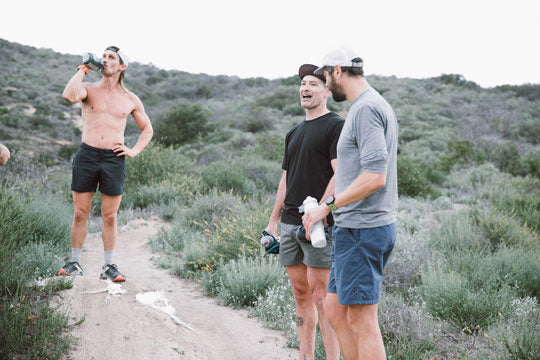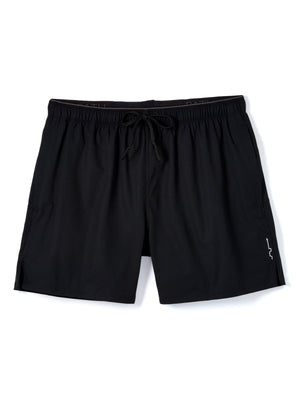Guest post by our good friend Andy Blow from Precision Fuel & Hydration. At Path Projects we have been using their products for years and we always appreciate the insights Andy shares about hydration and nutrition for athletes.
--
Andy: Determining how much to drink when training in hot weather depends on a number of factors, the main ones being:
- the duration and intensity of the session.
- your individual sweat rate (i.e. how much sweat you lose per hour).
- and practical considerations around the ability to carry or pick up drinks during your run.

Breaking these factors down, it’s fair to say that most sessions under 1 hour, even in really hot and humid conditions, don’t require significant fluid intake, assuming you’re well-hydrated at the start. Even if you sweat a lot you’re highly unlikely to become really dehydrated in an hour, so simply sipping water or a light electrolyte drink as you feel you need to is usually the only strategy you need.
When you’re out there for over an hour, and certainly beyond 90 minutes, drinking somewhere between ~250ml (~8oz) and 750ml (~24oz) per hour is in the ballpark for what the majority of runners will benefit from consuming.
The lower end of the range applies to shorter, easier runs and/or for those with naturally lower sweat rates, whereas the higher end is for longer efforts when the intensity is high and for those who experience heavy sweat losses. Some trial and error is needed to dial in the amount that works for you and measuring your sweat rate can give you some useful data to help this process.
Whilst you don’t need to aim to replace 100% of what you lose during a run, keeping body weight loss to within ~1-3% is generally sensible as more than that can compromise performance and subsequent recovery from the session. This is important to remember when you’re in a period of heavy training as what you can get away with drinking on a long, hot run and what’s optimal for recovery afterwards are often very different.

Sometimes you’ll be limited to how much you can drink by access to fluids during a run. If you’re training in an urban environment or somewhere you know you can reliably get additional fluids, it’s fine to skimp on what you carry if you’re prepared to stop and refill bottles or buy a drink from a gas station.
It’s a totally different story if you’re heading into the wilderness on a hot day for a long run and careful planning to figure out how much water you think you’ll need. So, adding a decent amount on top as a safety measure and then getting a comfortable pack in which to carry it is essential.
In terms of what to drink in hot conditions, water and/or hypotonic electrolyte drinks tend to be the best bet as they are more readily absorbed than isotonic or hypertonic drinks with high carb contents. Whilst a little bit of sugar (along with sodium) can speed up the absorption of fluid in the gut, too much can slow digestion down and cause sickness or bloating. Therefore, pairing low or no-sugar electrolyte drinks with gels, energy bars and other snacks makes the most sense to keep you adequately hydrated and energized when sweat losses are high.
Sodium is the predominant electrolyte you’ll lose in sweat and making sure you’re taking sufficient sodium in with fluids is a very good idea if you’re a heavy sweater exercising beyond about 60 minutes and for just about anyone who’s running for 90 minutes or more.
As a rule of thumb, ~500mg of sodium per liter of water consumed is a good ratio for lighter sweaters and as much as 1,500mg per liter can be required for those with very heavy sweat and salt losses. The free hydration planner tool on the Precision Fuel & Hydration website is a useful resource for figuring out whether you’re likely to need a smaller or larger amount of sodium on your runs.

Path Projects: For summer race season, how do you determine the best personalized hydration strategy for races of 3 hours and longer?
Andy: When you’re racing for multiple hours, hydration (and fueling) play a big part in success or failure as, no matter your fitness level, it’s impossible to maintain optimal performance for that duration without eating and drinking.
Hydration needs can vary dramatically from person-to-person based on individual variation in sweat rate and sweat sodium losses between athletes.
On the lower end, we have seen case studies of runners taking in as little as ~110ml of fluid and no sodium per hour during a hot marathon (without achieving what would be described as a best-case performance), whilst on the higher side we’ve seen others clocking over 1.1 liters per hour and nearly 1,000mg sodium per hour in a similar timeframe; a 10x difference in total fluid intake! This goes to show the extreme amount of inter-individual variability in hydration intake but in reality most people will find they fall somewhere between these numbers.

The best place to start with determining what will work for you as an individual is to measure your sweat rate in similar conditions and at a similar pace to those you’ll face on race day. This will give you an idea of the total magnitude of sweat loss you’re likely to have to deal with. Replacing enough fluid to limit losses to within 1-3% of body weight is a sensible starting point to aim for and some trial and error in training is the best way to hone in on exactly what will work for you on race day.
For sodium needs, ~500mg of sodium per liter of water consumed is a sensible ratio for lighter sweaters and as much as 1,500mg per liter can be required for those with very heavy sweat and salt losses. Subjectively, if you’re someone who regularly sees salt stains on your skin or kit, gets light-headed or dizzy after long runs in the heat or suffers with muscle cramps, these are all possible signs of high sodium losses.
The free hydration planner tool on the Precision Fuel & Hydration website is a very useful resource for figuring out whether you’re likely to need a smaller or larger amount of sodium in longer races.






